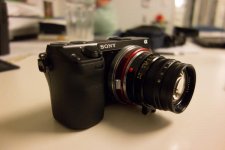chris91387
Well-known
hey all, i'm a long time RFF'er but i just got an NEX 7 and i have a question.
i just mounted my 1984 50mm summicron with a metabones adapter and the images feel a bit soft. they don't feel as sharp as i remember when i used this lens with my M4 back in the day.
i've been using the focus peaking and am a bit surprised by the amount of "play" in the focusing without the peaks moving. so i've tried zooming in and focusing that way but when i get into Lightroom i'm still not seeing that tack sharp leica look that i expect. don't get me wrong, it's not fuzzy or anything, just not real sharp. i have the camera in shutter speed priority with auto iso. i'm usually keeping the lens around f2-f4.
i can send someone a raw file if you want to see. just PM me your email address.
does anyone have any secrets to getting good sharp images?
thanks.
i just mounted my 1984 50mm summicron with a metabones adapter and the images feel a bit soft. they don't feel as sharp as i remember when i used this lens with my M4 back in the day.
i've been using the focus peaking and am a bit surprised by the amount of "play" in the focusing without the peaks moving. so i've tried zooming in and focusing that way but when i get into Lightroom i'm still not seeing that tack sharp leica look that i expect. don't get me wrong, it's not fuzzy or anything, just not real sharp. i have the camera in shutter speed priority with auto iso. i'm usually keeping the lens around f2-f4.
i can send someone a raw file if you want to see. just PM me your email address.
does anyone have any secrets to getting good sharp images?
thanks.


